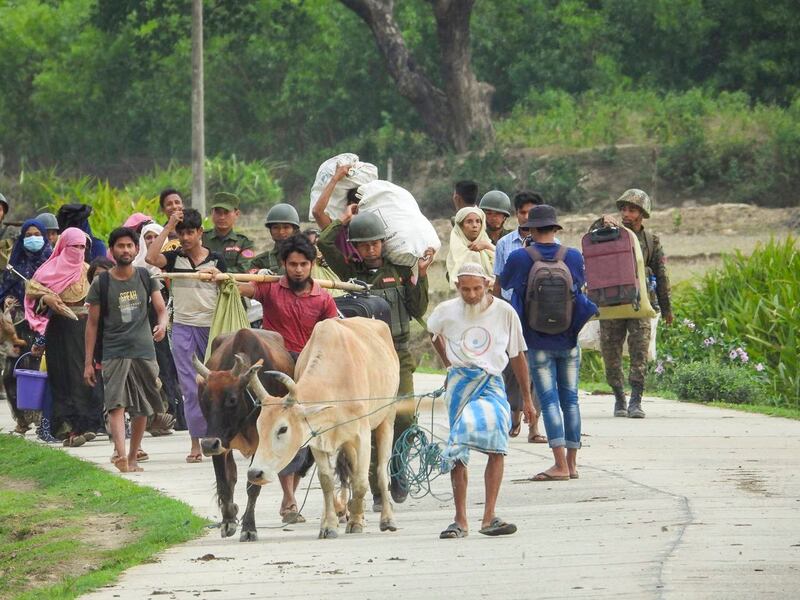Around 7,000 Rohingyas in western Myanmar’s Rakhine state are sheltering in rebel territory amid escalating tensions between the military and the Arakan Army, according to residents and the AA.
Some 600,000 members of the mostly Muslim ethnic group remain in the state after a military clearance operation sent more than 700,000 fleeing to safety in neighboring Bangladesh in 2017. They face restrictions on movement and the threat of renewed violence, leaving them vulnerable to fighting that erupted in the region in November.
That’s when the Arakan Army, or AA, of ethnic Rakhine fighters suspended a ceasefire agreement that had been in place since the military’s February 2021 coup d’etat.
On May 8, some 7,000 Rohingyas fled the Buthidaung township’s villages of Ka Kyet Bet, Kan Pyin, Myaung Nar, Ah Lel Chaung, Ba Gon Nar and Let Thar, where junta troops are firing artillery and conducting airstrikes, the AA’s Humanitarian and Development Coordination Office said in a statement on Monday. It said some of the Rohingyas fled to the pro-junta No. 8 Border Guard Police Battalion in Buthidaung.
Highly produced video footage released by the AA on Sunday appeared to show rebel troops escorting Rohingya civilians – including children, the elderly and the disabled – and providing them with humanitarian assistance.
Rohingya sources say the situation in Rakhine state has grown increasingly complex in recent weeks and that members of their ethnic community are being exploited and oppressed by both the military and the AA.
But a resident of Buthidaung, who spoke on condition of anonymity due to security concerns, told RFA Burmese that the AA has welcomed the thousands of displaced Rohingya.
“Troops of the United League of Arakan/the Arakan Army have provided the fleeing Rohingya with shelters and other fundamental needs, as well as medicines and medical treatment,” the resident said. “The AA is expected to give shelter to the Rohingya, depending on the [conflict] situation.”
Residents and members of the AA declined to provide information on where the Rohingyas had sheltered, citing consideration of their safety. Attempts by RFA to reach members of the Rohingya community that fled went unanswered Monday.
Tens of thousands on the run
The group of Rohingyas is the latest to join a greater exodus of civilians trying to outrun violence in Rakhine state.
On May 9, Nay San Lwin, a Rohingya rights activist who is monitoring the situation, told RFA that at least 40,000 Rohingyas had been forced to flee intense clashes between junta troops and the AA in Buthidaung and Maungdaw townships since the start of the week, and are now facing a humanitarian crisis.
He said that the Rohingyas would not be provided aid because they are “not allowed to take shelter at IDP [internally displaced people] camps.”
Rohingya activists estimate the Rohingya population of Buthidaung to be around 200,000 and of Maungdaw to be some 80,000, totaling nearly 300,000 people. Those who fled last week accounted for nearly 15% of the Rohingya population in the two townships.

Widespread gains by the AA have prompted the junta to implement a draft to shore up depleted troop losses.
As part of its efforts, the military has reportedly forcibly recruited Rohingyas into pro-junta militias which it says must be formed to protect their Muslim faith in majority Buddhist Rakhine state.
But observers say the junta is trying to stoke ethnic tensions in the region to slow the Arakan Army’s advance.
‘A good sign’
On Monday, Nay San Lwin welcomed the AA’s assistance to the fleeing Rohingyas.
“The AA has also provided shelter to Rohingya people in other areas,” he said. “Both communities are living in the AA-controlled areas. It is a good sign. We have always encouraged them [the AA] to promote peaceful coexistence and rebuilding in areas devastated by the fighting.”
RFA was unable to reach Hla Thein, the junta’s spokesperson for Rakhine state, by telephone for comment on Monday.
The AA seized the military’s No. 15 Operations Command Headquarters and its four battalions in Buthidaung township during the first week of May, and the rebel group is continuing an offensive against the remaining battalions.
The United Nations Office for the Coordination of Humanitarian Affairs announced on May 1 that more than 160,000 civilians have fled their homes since fighting resumed last year in Rakhine state.
The more than 700,000 Rohingya villagers who fled Myanmar in 2017 joined hundreds of thousands who escaped the country in previous years, bringing the total number languishing in camps for the displaced in Bangladesh to around 1 million, according to the latest U.N. figures.
Translated by Aung Naing. Edited by Joshua Lipes and Malcolm Foster.
